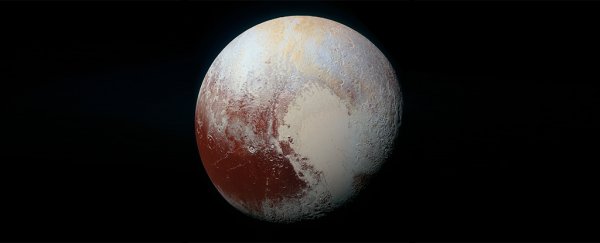The International Astronomical Union (IAU) has formally accepted the list of themes that can be used to name new features discovered on Pluto and its five moons – and it seems the trend of underworld-inspired names isn't going anywhere any time soon.
Nearly two years after SETI closed the ballot on the Our Pluto project, it looks like we can expect more hellish names like Chthulu Regio, Balrog Macula, and Tartarus Dorsa out in our Solar System's cold outer limits.
Since its launch in 2006, NASA's New Horizons mission has sent back over 50 gigabits of data on its history-making Pluto flyby mission, including galleries of snapshots of the distant dwarf-planet and its five moons – Styx, Nix, Kerberos, Hydra, and, the largest, Charon.
Astronomers are still sifting through the information, and will continue to do so for a long time to come.
But as we find out more about the distant former-planet, the surprises keep coming, revealing a body far more dynamic and exciting than any frozen ball has a right to be – gigantic towers of ice, a strange heart-like plain which would slowly 'beat' over the millennia, and hints of a liquid ocean beneath its skin.
Of course, with each new discovery, astronomers need a handy list of names to select from.
According to the International Astronomical Union, not just any old name will do. Their rules dictate that once we received the first images of a body's surface, we need to declare a theme for naming them.
This job usually comes down to an IAU task group; in this case, however, the job was handed to the general public as part of a project hosted by the Search for Extra-terrestrial Intelligence Institute, called Our Pluto.
And the people have made it clear they want to continue with the theme of naming parts of Pluto based on the underworld.
It was an 11 year-old girl rather than an astronomer who in 1930 suggested the recently discovered icy ball of rock should be named after the Greek god of the underworld, so it was only appropriate that the public had a say in the names for its craters, canyons, cliffs, and crags today.
Anybody could vote on themes and suggest names for the features of Pluto and its moons, which led to a democratically chosen list of themes.
Now the IAU has accepted the list, allowing them to formally begin locking in the many dark, hellish names that have come to identify the mountain ranges, seas, and ravines of these distant worlds.
"We have been delighted to be able to share the excitement of the New Horizons mission with people from all over the world," said Mark Showalter, a scientist at the SETI Institute and the New Horizons team member who organised the campaign.
"I look forward to seeing many of the public's thoughtful suggestions officially assigned to the maps of Pluto and its moons."
While astronomers have made a head start with many names, none have been formally accepted as of yet.
Thanks to public appeal, the IAU accepts the following themes for the dwarf-planet and its satellites.
Pluto
- Gods, goddesses and other beings associated with the underworld from mythology, folklore and literature
- Names for the underworld and for underworld locales from mythology, folklore and literature
- Heroes and other explorers of the underworld
- Scientists and engineers associated with Pluto and the Kuiper Belt
- Pioneering space missions and spacecraft
- Historic pioneers who crossed new horizons in the exploration of the Earth, sea and sky
Charon
- Destinations and milestones of fictional space and other exploration
- Fictional and mythological vessels of space and other exploration
- Fictional and mythological voyagers, travellers and explorers
- Authors and artists associated with space exploration, especially Pluto and the Kuiper Belt
Pluto's four smaller moons
- Styx: River gods
- Nix: Deities of the night
- Kerberos: Dogs from literature, mythology and history
- Hydra: Legendary serpents and dragons
Maybe one day in the far future, your descendants will visit Burney Crater, and pay homage to a little girl who thought a frozen nether-world deserved a classically purgatorial name.
